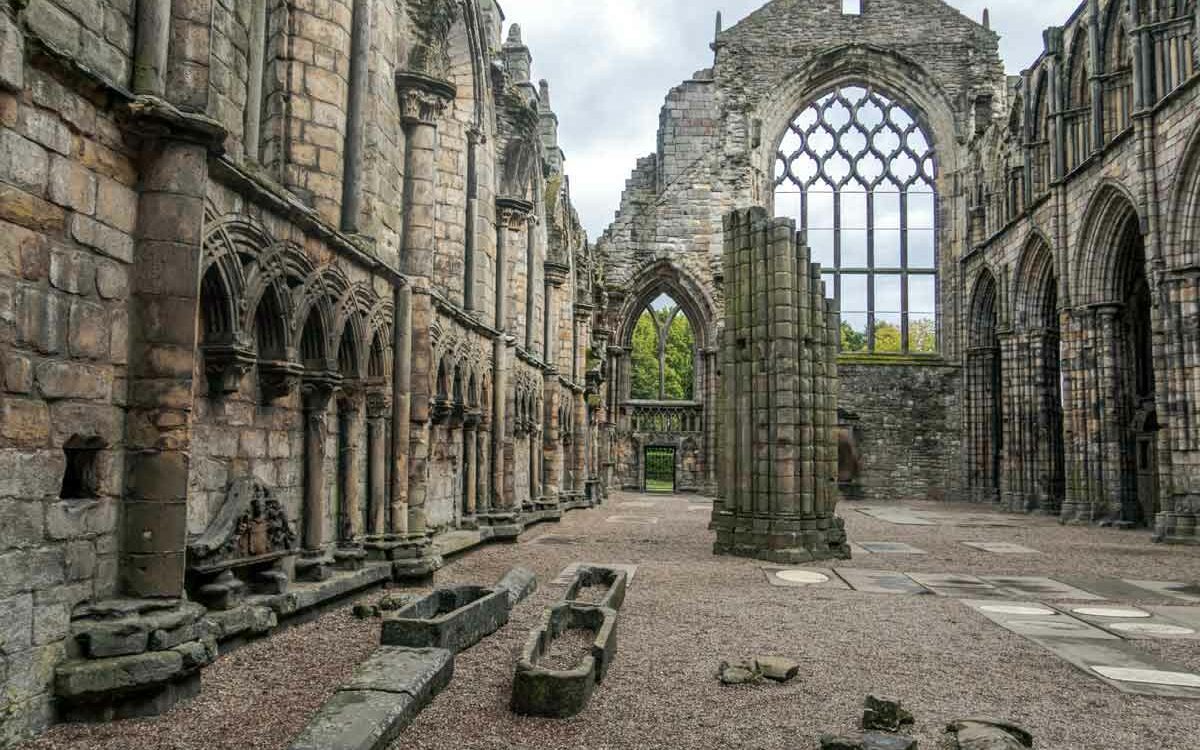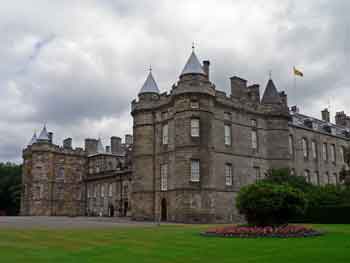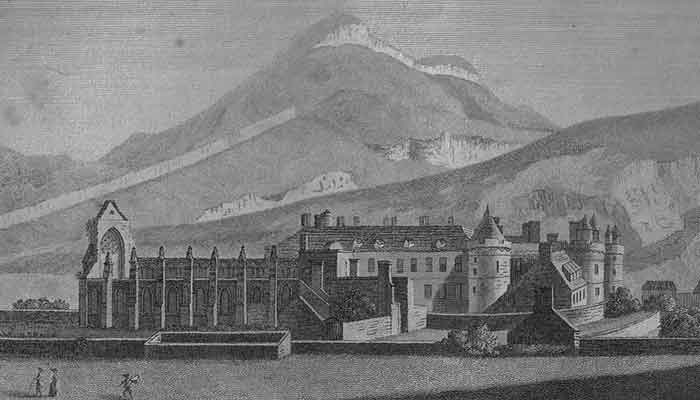Holyrood Abbey, founded by King David I in 1128, stands in the grounds of the Palace of Holyroodhouse on the edge of Holyrood Park.

The History of Holyrood Abbey
Like much of Scotland’s history from that period, the motivation behind the abbey’s establishment is rooted in legend and superstition.
King David I, hunting in the forest of Drumsheugh (an ancient part of Edinburgh) was suddenly charged by a large stag.
Thrown from his horse he tumbled to the ground raising his arms in protection from the antlers as he fell.
Instead of piercing antlers, he clutched a cross, a holy rood. That night he dreamt that a religious house should be built on the spot of his miraculous escape.
While this version of the story of the abbey’s origin is widely quoted there is also another more intriguing version.
David founded the abbey in honour of a golden cross, containing part of the ‘true cross’ owned by his mother Margaret who was the wife of King Malcolm III of Scotland.
A chapel built by David in memory of his mother around 1130 within the grounds of Edinburgh Castle, it is the oldest building in Edinburgh
Canongate, today one section of the Royal Mile

Holyrood Abbey was built outside Edinburgh’s city walls in an area that became known as the Canongate, named after the Augustinian canons.
This ancient thoroughfare only became part of Scotland’s capital in the 19th century.
It survives today as one section of the Royal Mile which runs from Edinburgh Castle to the site of the Abbey of Holyrood.
During his reign David, who earned the epithet “Saint David” for his lavish gifts to the church, also established the great Cistercian abbeys at Melrose and Newbattle and the Augustinian abbey at Jedburgh.
It’s also believed that he founded the Augustinian abbey at Cambuskenneth near Stirling, although the original charter has never been found.
David’s devotion was clearly shown in the generous conditions contained in the original Latin charter.
The charter allowed the canons of the Church of the Castle “leave to establish a burgh between that church and my burgh [Edinburgh].”
Church of the Castle
The use of the name “Church of the Castle” in the charter raises an interesting point of discussion.
Respected Scottish historian David Daiches speculated that “The Abbey of Holyrood may first have had a brief existence at the foot of the (Edinburgh) Castle Rock.”
The king’s choice of the first abbot was perhaps a natural one, a man he had grown to trust, his own confessor Alkwine who held the abbacy until his death in 1150.
A visit to Holyrood Abbey
When a young Felix Mendelssohn visited in 1829, he noted that the abbey’s chapel, little more than a ruin, had lost its roof and was overgrown with grass and ivy. Everything, he said was ruined, decayed and open to the sky.
Holyrood Abbey: archaeology
Over the years, archaeologists have unearthed a number of objects which told us a little about monastic life and more ancient times before the first monks arrived.
Historic Environment Scotland’s archaeological notes have a few details.
In 1953, for example, archaeologists discovered human remains, possibly, 38 people, in what they described as a post-medieval cemetery at the abbey church.
Among the other finds were a few coins dated c. 1300 and a French-made copper jetton. Archaeologists also found a denarius (small silver coin) of Marcus Aurelius c. 161 to 180 CE.
The National Museum of Scotland now has the Roman coin on display.
In 1995, Historic Scotland began a small-scale archaeological dig which produced some excellent results including some human remains, interred in a medieval cemetery dating to the 14th century.
Among the debris were broken window glass and the cames that held it in place, almost certainly the result of King Edward II of England’s attack in 1322 during Scotland’s bloody Wars of Independence.

Edward had brought a large army north to Scotland but Robert Bruce’s policy of clearing the land of any sources of food worked well, forcing Edward’s hungry army to retreat south.
However in the words of Fordun, not before Edward’s army, “Sacked and plundered the monasteries of Holyrood in Edinburgh and Melrose…”
John of Fordun
It’s worth digressing for a moment to briefly look at the role of John of Fordun in the chronicling of Scottish history.
Although he is widely regarded as providing an invaluable service in the telling of Scotland’s early stories, his historical fact is almost certainly mixed with a dash of myth and folklore.
For example, Fordun talks of the sacking and plundering of Holyrood Abbey but either considerable rebuilding took place over the following years or the damage was less than described, for Robert Bruce held a parliament at the Abbey in 1327.
Bannatyne Club
In the search for more authoritative sources, historical researchers must be grateful to Sir Walter Scott and the Bannatyne Club, an organisation established in 1823 to print rare works of Scottish interest.
Some of the early Scottish charters, many of them re-discovered by the Bannatyne Club were re-interpreted in the light of more contemporary information providing significant detail relating to the development of the abbey.
Other valuable sources were added to the picture. In 1329, the year Robert the Bruce died, the Exchequer Rolls of Scotland show two grants to Holyrood Abbey: one for kitchen utensils and one for wine.
It’s an easy one to treat simply as mere housekeeping but combined with other contextual evidence, the Exchequer Roll entries are key to a better understanding of what life was like within the abbey walls.
Edward I
In 1296 the abbey survived the unwelcome attentions of another English king intent on maximum destruction in Scotland.
The Scots, finding common ground with the French had signed the “Auld Alliance” an agreement designed to put a stop to English expansion.
The treaty between two of England’s greatest enemies brought an immediate and belligerent response from its king.
Determined to ‘deal’ with the Scots, Edward I sent his army north. Following three days of destruction and slaughter at Berwick, Edward’s army moved on to Dunbar where it easily defeated the Scots.
As castles, including the great hilltop fortress at Edinburgh, and religious houses fell to the advancing forces, it was a pragmatic Abbot Adam who swore an oath of fealty to Edward in the abbey’s chapter house, a few stones of which remain today.
In return, Edward guaranteed the safety of the monastery and its surrounding lands.
James IV
It was James IV, Scotland’s Renaissance king, who first began the process of converting the abbey into a royal palace.
By the time he married Margaret Tudor, daughter of Henry VII in 1503, Holyrood had developed into a substantial palace more suitable for its royal residents.
A number of royals are buried in Holyrood Abbey, as is Henry Stuart the second husband of Mary Queen of Scots who lies in what is now the nave’s south aisle.
Holyrood abbey: SUGGESTIONS FOR FURTHER RESEARCH & READING
- Bain, S., Bateson, J.D., Clark, J., Hazel, C., O’Sullivan, T. and Will, R.S., 1999, November. Excavations of a medieval cemetery at Holyrood Abbey, Edinburgh. In Proceedings of the Society of Antiquaries of Scotland (Vol. 128, pp. 1047-1077).
- Gallagher, D.B., 1999, November. Holyrood Abbey: the disappearance of a monastery. In Proceedings of the Society of Antiquaries of Scotland (Vol. 128, pp. 1079-1099).
- Theodossopoulos, D., 2016. The catastrophic repairs of Holyrood Abbey church in 1760. International Journal of Architectural Heritage, 10(7), pp.954-974.
- Harrison, J., 1919. The History of the Monastery of the Holy-Rood and of the Palace of Holyrood House. W. Blackwood and Sons.
Holyrood Abbey visitor information
For information on opening hours, cost of entry and other tips to help you plan your visit, go to the Royal Collection website.